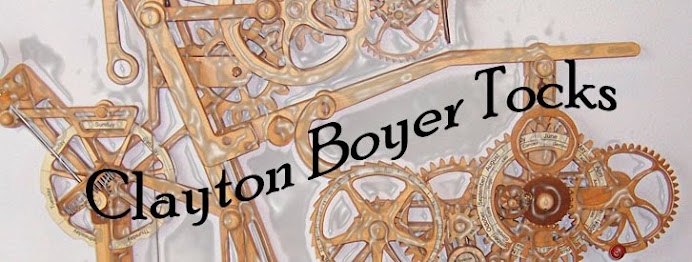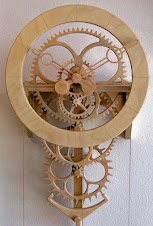Bob L. emails: Hi, I am considering your
Toucan clock plans. I have a little past experience in gear design, and
am thinking of making the gears by a different method than scroll sawing.
Because of this, I wonder if you tell me:
1) Do the gears in
the Toucan have the common "involute" profile or are they a different
profile??
2) What diametral
pitch are gears in the Toucan??
 |
| Toucan by Jeff Hecht |
Aloha Bob, it is nice to hear from you and I'm glad you enjoyed
viewing my site. The Toucan is a wonderful, fun and easy to build
clock. It's my top design engendering the creativity and personalization
of the various builders. You can see many of their delightful "brain
children" in the Flickr' pool of builder' pix (link on the Toucan order
page). Those pix really are worth viewing for some great ideas.
And
how can I say that it is easy to build? Because when you are looking
through the Flickr' pool of builder's pix the first one is of a 13 year old boy
that successfully built the Toucan. Of course, maybe he's just a
genius(?).
Gear design is a very popular topic and lots of time is spent on
gear design in engineering books. I write many pages in my book about
gear design as it relates to wooden clock building, and I really do need to
create a blog post about the topic.
First we have to ask ourselves what the purpose of the gears
really is, and what is their real function?
We could simply have two circles turning edge to edge and get the
same ratio, but without the addendums and dedendums (the uppity and downity
parts of the tooth) of spur gears our circle gears could easily slip.
Slippage would cause a deficiency of the transmission of the driving force
through the system, but more than that, in a clock slipping wheels would also
cause the hands to show the incorrect time and even cause a desynchronization
of the relationship of the minute to hour hands.
However, that does not mean we cannot use edge driven circles in
our clock designs. Take a look at my Horologium and you'll see that the
hour wheel is actually a pulley run by the drive weight cord. The gear
ratio is maintained by the barrel diameters of the drive pulley and hour
wheel. http://www.lisaboyer.com/Claytonsite/horologium.htm
So basically the "teeth" on a gear do two things for us;
they efficiently transmit the driving force, and by doing so they prevent
misalignment caused by slippage of the wheels.
When we are contemplating tooth forms for a particular mechanism,
a couple other things that need consideration is the speed of transmission of
the drive force, and the direction of that force through the gear
train.
In a clock the transmission of force is extremely slow. In
the normal grandfather clock the fastest wheel only turns one revolution per
minute. This slow transmission of forces allows for some very forgiving
tooth forms. There are medieval metal clocks that are still operational
with simple triangular shaped tooth forms. Some of the teeth in the very
early wooden clocks were created with hand tools and look as though some teeth
were hacked into shape. These inefficiency of these irregularities and
imperfections many times can easily be overcome with a bit more drive
weight.
It is only when we have gears rapidly moving together that we
actually need the perfect involute gears with close tolerances that we've all
learned about in physics class. There are other very efficient ways of
transmitting power through the system without the use of involute gears.
Take a look at my Vortex. Vortex has straight sided teeth on all of its
gears. Straight sided gear teeth are about as far from the perfect
involute curve as you can get. Scroll down the page a little further and
take a look at the side view and you'll see how I created the roller lantern
pinions that perfectly match with the straight sided tooth forms of the wheels
to give excellent power transmission and minimize contact friction. http://www.lisaboyer.com/Claytonsite/vortexpage1.htm
And the last thing to consider is the direction of the forces
transmitted through the gears. Clocks run in only once direction.
Clocks do not ever run in reverse. That means that the back side of the
gear tooth never gets used and can be created in any form that the designer
favors, as long as it does not interfere with the incoming tooth from the other
gear. Most of the time we simply make it a mirrored reflection of the
front side of the tooth, but that mirroring is not necessary since that back
side of the tooth is never used in a clock.
Most all of my tooth designs are of a modified involute design
because even as forgiving as these wonderful mechanisms are one of the goals of
a good design is to try and decrease the amount of driving force
required. Involute-like teeth help with that, but as we've discussed
above involute tooth forms have no particular spiritual holiness sent from the
God of Physics. This gives us a tremendous latitude in design. We
can make our teeth straight sided, curved sided, or perfectly involute, but I
have to chuckle because whatever tooth form we choose, we still don't need the
back of it.
Enjoy! Aloha. Clayton

